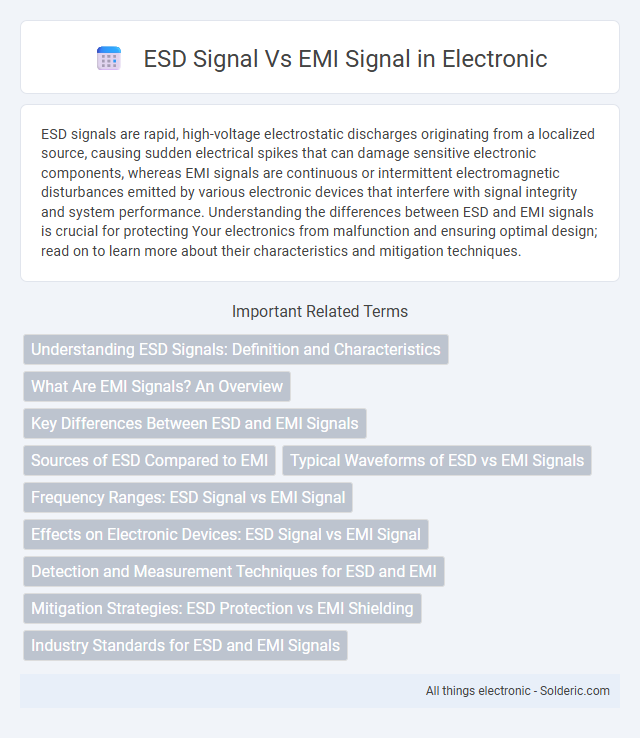ESD signals are rapid, high-voltage electrostatic discharges originating from a localized source, causing sudden electrical spikes that can damage sensitive electronic components, whereas EMI signals are continuous or intermittent electromagnetic disturbances emitted by various electronic devices that interfere with signal integrity and system performance. Understanding the differences between ESD and EMI signals is crucial for protecting Your electronics from malfunction and ensuring optimal design; read on to learn more about their characteristics and mitigation techniques.
Comparison Table
| Aspect | ESD Signal | EMI Signal |
|---|---|---|
| Definition | Electrostatic Discharge: sudden flow of static electricity between two objects | Electromagnetic Interference: unwanted electromagnetic noise affecting electronic circuits |
| Cause | Static charge buildup and rapid discharge | Electromagnetic radiation from devices or natural sources |
| Signal Type | High voltage, short duration pulse | Continuous or intermittent electromagnetic waves |
| Frequency Range | Broad spectrum, often high-frequency spikes | Wide frequency spectrum depending on source |
| Impact on Electronics | Potential damage or malfunction from voltage spikes | Signal degradation, data errors, or equipment malfunction |
| Mitigation Methods | ESD protection devices, grounding, shielding | EMI shielding, filtering, proper circuit design |
Understanding ESD Signals: Definition and Characteristics
ESD signals, or electrostatic discharge signals, are abrupt, high-voltage pulses caused by the rapid transfer of static electricity between two objects with different electrical potentials. These signals typically exhibit extremely fast rise times, often in the nanosecond range, and high peak currents that can cause damage to sensitive electronic components. Understanding the transient nature, amplitude, and frequency spectrum of ESD signals is crucial for designing effective protection mechanisms against electrostatic discharges in electronic devices.
What Are EMI Signals? An Overview
EMI signals, or Electromagnetic Interference signals, are unwanted disturbances generated by external electromagnetic sources that disrupt the normal operation of electronic devices. These signals can originate from various sources such as power lines, electrical motors, or wireless transmitters, causing data corruption or degraded performance in sensitive equipment. Understanding EMI signals is crucial for designing effective shielding and grounding techniques to protect your devices from interference and ensure reliable functionality.
Key Differences Between ESD and EMI Signals
ESD (Electrostatic Discharge) signals are brief, high-voltage spikes caused by static electricity discharge, while EMI (Electromagnetic Interference) signals consist of continuous or intermittent electromagnetic noise disrupting electronic devices. ESD events typically last nanoseconds and affect device insulation, whereas EMI signals can persist longer and interfere with signal integrity across circuits. Understanding these key differences helps you implement the appropriate protection methods for sensitive electronics and improve overall system reliability.
Sources of ESD Compared to EMI
ESD signals primarily originate from sudden electrostatic discharges caused by human contact, triboelectric effects, or charged objects discharging to grounded surfaces. EMI signals arise from continuous or intermittent electromagnetic radiation emitted by electronic devices, power lines, radio transmitters, and switching circuits. Understanding these distinct sources enables effective design of protection strategies against both ESD and EMI disturbances.
Typical Waveforms of ESD vs EMI Signals
Typical waveforms of ESD signals exhibit sharp, high-amplitude spikes with very short durations, often in the range of nanoseconds to microseconds, reflecting their impulsive nature. EMI signals generally show more continuous or repetitive waveforms with lower amplitude but longer durations, spanning microseconds to milliseconds, corresponding to oscillatory or modulated interference sources. The distinct temporal and amplitude characteristics of ESD and EMI waveforms are crucial for designing effective protection and filtering strategies in electronic circuits.
Frequency Ranges: ESD Signal vs EMI Signal
ESD signals typically exhibit very high-frequency components ranging from MHz to several GHz, often characterized by fast rise times and short duration pulses. EMI signals span a broader frequency spectrum, commonly from low kHz frequencies up to GHz, depending on the source and nature of interference. Understanding these distinct frequency ranges is crucial for designing effective filtering and shielding solutions in electronic systems.
Effects on Electronic Devices: ESD Signal vs EMI Signal
ESD (Electrostatic Discharge) signals cause sudden, high-voltage spikes that can instantly damage sensitive electronic components, potentially leading to device failure or data corruption. EMI (Electromagnetic Interference) signals generate continuous or intermittent noise that disrupts the normal operation of electronic circuits, causing degraded performance, signal loss, or malfunction over time. Your electronic devices require robust protection measures tailored to mitigate both ESD's instantaneous surges and EMI's persistent disturbances to maintain optimal functionality.
Detection and Measurement Techniques for ESD and EMI
Detection and measurement of ESD signals rely on fast transient analyzers and high-bandwidth oscilloscopes to capture rapid voltage spikes often in the nanosecond range. EMI signals are typically measured using spectrum analyzers and EMI receivers that evaluate frequency-domain interference over a broad spectrum, identifying both conducted and radiated emissions. Your choice of equipment should align with the signal characteristics, as ESD requires time-domain precision while EMI demands frequency-domain analysis.
Mitigation Strategies: ESD Protection vs EMI Shielding
ESD protection employs targeted components like transient voltage suppressors and grounding techniques to instantly neutralize electrostatic discharges, preventing damage to sensitive electronics. EMI shielding uses conductive or magnetic materials such as metal enclosures and ferrite beads to block or absorb electromagnetic interference, maintaining signal integrity in electronic circuits. You can enhance device reliability by integrating ESD protection elements alongside comprehensive EMI shielding solutions tailored to your application's frequency and sensitivity requirements.
Industry Standards for ESD and EMI Signals
Industry standards for ESD signals, such as IEC 61000-4-2, define test methods and severity levels to ensure device robustness against electrostatic discharge. EMI signals are governed by standards like CISPR 22 and FCC Part 15, which specify limits on electromagnetic emissions to prevent interference with other electronic equipment. Understanding these standards helps you design products that maintain compliance and reliability in various electromagnetic environments.
ESD signal vs EMI signal Infographic

 solderic.com
solderic.com